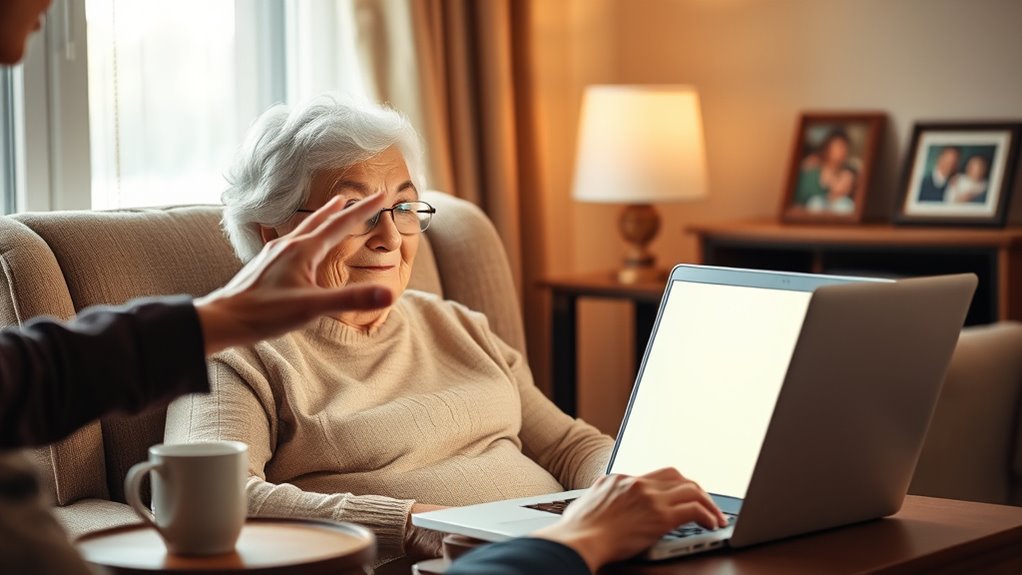When you become a long-distance caregiver, start by gathering detailed information about your loved one’s health, medications, and appointments. Establish an emergency plan and identify local contacts for quick help. Set up reliable communication methods like calls or video chats, and organize important documents digitally. Regular check-ins will help you monitor their well-being, while building a support network eases your responsibilities. Taking these initial steps will make managing their care more manageable, and there’s more to explore to ensure their safety and comfort.
Key Takeaways
- Initiate open communication with your loved one to understand their current health needs and preferences.
- Gather essential medical documents and share access securely with trusted contacts.
- Set up a centralized system or digital tools to track appointments, medications, and emergency contacts.
- Establish a regular check-in routine to monitor health and emotional well-being remotely.
- Build a support network of family, friends, and professionals to share responsibilities and ensure safety.

Are you unsure where to begin as a long-distance caregiver? It can feel overwhelming at first, but establishing a clear plan helps you feel more confident and in control. The first step is understanding your loved one’s medical needs. Reach out to their healthcare providers to gather information about their current medical appointments, medications, and any ongoing treatments. Staying informed ensures you can help coordinate care from afar and make sure they attend all necessary medical appointments. Keep a detailed list of their medications, dosages, and pharmacies for easy reference, and consider setting reminders for upcoming appointments.
Next, prioritize emergency planning. It’s crucial to know what steps to take if your loved one faces a sudden health crisis. Talk with them about their wishes in case of an emergency and ensure they have a clear plan in place. Identify a trusted local contact, such as a neighbor, friend, or nearby family member, who can check in regularly and act quickly if needed. Make sure they have quick access to important documents like their insurance information, medical history, and emergency contacts. Keep these documents in a secure, accessible location, either digitally or physically. Also, discuss with your loved one what kinds of emergencies are most likely and plan accordingly—whether it’s a fall, a sudden illness, or a home repair issue that could impact their safety.
To stay organized, create a centralized system for managing appointments, medications, and emergency contacts. Digital tools, such as shared calendars or care management apps, can make it easier to stay updated and communicate with your loved one’s healthcare team. Regularly check in with your loved one to ensure they’re managing their health well and to address any new concerns. Establish a routine for ongoing communication, whether through phone calls, video chats, or even visits when possible, to maintain a personal connection and monitor their well-being. Additionally, consider using air purifiers with HEPA filters to help improve indoor air quality, especially if your loved one has allergies or respiratory issues.
Finally, remember that you don’t have to do everything alone. Building a support network of family, friends, and professional caregivers can lighten your load. Collaborate on tasks like attending appointments or managing emergencies, and don’t hesitate to ask for help when needed. Starting with these foundational steps—understanding medical appointments and emergency planning—sets a solid groundwork for your role as a long-distance caregiver. It helps you provide effective support, ensures your loved one’s safety, and gives you peace of mind knowing you’re doing everything you can, even from afar.
Frequently Asked Questions
How Do I Establish Reliable Communication Channels With My Loved One?
You can establish reliable communication channels by choosing consistent communication strategies, like scheduled calls or video chats, to stay connected regularly. Use trust-building techniques such as active listening and expressing genuine concern to strengthen your relationship. Keep devices accessible and make sure your loved one knows how to reach you easily. This consistency and trust will help you maintain open, dependable communication, making your long-distance caregiving more effective and reassuring for both of you.
What Legal Documents Should I Prepare Before Becoming a Long-Distance Caregiver?
Did you know nearly 60% of adults lack essential legal documents? As a long-distance caregiver, you should prepare a power of attorney and medical directives. These documents grant you authority to make financial and healthcare decisions, ensuring your loved one’s wishes are respected. Having these in place minimizes legal hurdles and provides peace of mind, allowing you to focus on providing care and support from afar.
How Can I Assess My Loved One’s Health Remotely?
You can assess your loved one’s health remotely by staying involved in their medical appointments, asking detailed questions, and listening carefully to their descriptions. Keep track of medication management, noting any changes or concerns they share. Encourage them to share updates via phone or video calls regularly. Consider using health monitoring apps or devices to stay informed about their essential signs and overall well-being, ensuring you’re proactive in their care.
What Technology Tools Are Most Effective for Remote Caregiving?
Your toolkit is your superpower, and the most effective tools are smart home devices and emergency alerts. Smart home technology allows you to monitor daily activities remotely, ensuring your loved one’s safety. Emergency alert systems provide instant communication in urgent situations. Together, these tools create a safety net, giving you peace of mind and enabling you to respond swiftly, even from miles away.
How Do I Coordinate With Local Caregivers or Services?
You should establish clear communication with local caregivers and coordinate with community resources to guarantee seamless support. Share emergency protocols and contact information, and set up regular check-ins to stay updated. Building a strong relationship with local providers helps you respond quickly when needed. Use technology to stay connected and informed, and make sure everyone understands their roles to ensure your loved one’s safety and well-being.
Conclusion
Taking these first steps can make a big difference in your loved one’s well-being. Remember, nearly 60% of long-distance caregivers report feeling overwhelmed, so it’s normal to feel unsure at first. Stay organized, communicate regularly, and seek support when needed. Your efforts matter more than you realize—your loved one benefits from your care and presence, even from afar. With patience and planning, you’ll build a strong support system that truly makes a difference.








